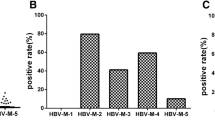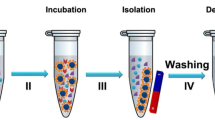Abstract
HPLC analyses of GM-CSF in solution mixtures containing both GM-CSF and HSA showed losses of GM-CSF which could not be accounted for using conventional electrophoretic and/or RP-HPLC techniques. Further investigation of these mixtures by immunoblotting and by immunoaffinity chromatography demonstrated the presence of high molecular weight (>67,000) GM-CSF related species. No such species was detectable in solutions of GM-CSF alone. This experiment pointed to the formation of an adduct between GM-CSF and HSA in the solution mixtures. To probe further the hypothesis of a GM-CSF/HSA adduct, an immunologically based test was conceived which could react only with this type of hybrid molecule. A sandwich enzyme-linked immunosorbent assay (ELISA) was developed using two antibodies, anti-GM-CSF (capture antibody) and anti-HSA (detection antibody), as part of the quantitation of GM-CSF/HSA adducts. After confirming its existence by ELISA, a GM-CSF/HSA adduct was isolated from the solution mixture containing both GM-CSF and HSA. This isolate served as a primary reference standard in the ELISA assay. The immunoassay has a subnanogram sensitivity and is highly specific for GM-CSF/HSA adducts in the presence of either free GM-CSF or free HSA. As a verification, conjugates of GM-CSF/HSA were synthesized using a cross-linking reagent. These covalent conjugates reacted positively in the ELISA and are employed as a convenient alternative reference standard.
Similar content being viewed by others
REFERENCES
D. Metcalf. The granulocyte-macrophage colony stimulating factors. Science 229:16–22 (1985).
G. Morstyn, L. Campbell, L. M. Souza, N. K. Alton, J. Keech, M. Green, W. Sheridan, D. Metcalf, and R. Fox. Effect of granulocyte colony stimulating factor on neutropenia induced by cytotoxic chemotherapy. Lancet 1:667–672 (1988).
K. H. Grabstein, D. L. Urdal, R. J. Tushinski, D. Y. Mochizuki, V. L. Price, M. A. Cantrell, S. Gillis, and P. J. Conlon. Induction of macrophage tumoricidal activity by granulocyte-macrophage colony stimulating factor. Science 232:506 (1986).
N. A. Nicola. Hemopoietic cell growth factors and other receptors. Annu. Rev. Biochem. 58:45–77 (1989).
J. L. Schrimsher, K. Rose, M. G. Simona, and P. Wingfield. Characterization of human and mouse granulocyte-macrophage-colony stimulating factors derived from Escherichia coli. Biochem. J. 247:195–199 (1987).
Y. J. Wang and M. A. Hanson. Parenteral formulations of proteins and peptides: Stability and stabilizers. J. Parenter. Sci. Technol. 42:Suppl. S1 (1988).
J. Geigert. Overview of the stability and handling of recombinant protein drugs. J. Parenter. Sci. Technol. 43:220–224 (1989).
Peters, T. Serum albumin. In C. B. Anfinsen, J. T. Edsall, and F. M. Richards (eds.), Advances in Protein Chemistry, Vol. 37, Academic Press, New York, 1985.
U. K. Laemmli. Cleavage of structural proteins during the assembly of the head of bacteriophage T4. Nature (London) 227:680–685 (1970).
B. R. Oakley, D. R. Kirsch, and N. R. Morris. A simplified ultrasensitive silver stain for detecting proteins in polyacrylamide gels. Anal. Biochem. 105:361–363 (1980).
H. Towbin, T. Staehelin, and J. Gordon. Electrophoretic transfer of proteins from polyacrylamide gels to nitrocellulose sheets: Procedure and some application. Proc. Natl. Acad. Sci USA 76:4350–4354 (1979).
W. N. Burnette. Western blotting: Electrophoretic transfer of proteins from sodium dodecylsulfate polyacrylamide gels to unmodified nitrocellulose and radiographic detection with antibody and radioiodinated protein A. Anal. Biochem. 112:195–203 (1981).
K. Yamaguchi and H. Asakawa. Preparation of colloidal gold for staining proteins electrotransferred onto nitrocellulose membranes. Anal. Biochem. 172:104–107 (1988).
P. K. Nakane and A. Kawaoi. Peroxidase labeled antibody. A new method of conjugation. J. Histochem. Cytochem. 22:1084–1091 (1974).
J. Carlsson, H. Drevin, and R. Axen. Protein thiolation and reversible protein-protein conjugation. Biochem. J. 173:723–737 (1978).
M. C. Manning, K. Patel, and R. Borchardt. Stability of protein pharmaceuticals. Pharin. Res. 6:903–918 (1989).
A. M. Klibanov and T. J. Ahern. Thermal stability of proteins. In Protein Engineering, Alan R. Liss, New York, 1987, pp. 213–218.
E. Engvall and P. Perlman. Enzyme-linked immunosorbent assay (ELISA). Quantitative assay of immunoglobulin G. Immunochemistry 8:871–874 (1971).
J. E. Butler. In D. M. Kemeny and S. J. Challacombe (eds.), ELISA and Other Solid Phase Immunoassays, John Wiley and Sons, New York, 1988, p. 155.
V. R. Anicetti, E. F. Fehskens, B. R. Reed, A. B. Chen, P. Moore, M. Geier, and A. J. S. Jones. Immunoassay for the detection of E. coli proteins in recombinant DNA derived growth hormone. J. Immunol. Methods 91:213–224 (1986).
N. Sunahara, S. Kawata, K. Kaibe, R. Furuta, M. Yamayoshi, M. Yamada, and S. Kurooka. Differential determination of recombinant human interleukin-1α and its deamidated derivative by two sandwich enzyme immunoassays using monoclonal antibodies. J. Immunol. Methods 119:75–82 (1989).
A. Dugaiczyk, S. W. Law, and O. E. Dennison. Nucleotide sequence and encoded amino acids of human serum albumin mRNA. Proc. Natl. Acad. Sci. 79:71–75 (1982).
R. Wetzel, M. Becker, J. Behlke, H. Billwitz, S. Bohm, B. Ebert, H. Hamann, J. Krumbiegel, and G. Lassman. Temperature behaviour of human serum albumin. Eur. J. Biochem. 104:469–478 (1980).
Author information
Authors and Affiliations
Rights and permissions
About this article
Cite this article
Kumarasamy, R., Bausch, J., Kopcha, D. et al. An Enzyme-Linked Immunosorbent Assay (ELISA) for Quantitation of Adducts of Granulocyte–Macrophage Colony Stimulating Factor (GM-CSF) and Human Serum Albumin (HSA) in Stressed Solution Mixtures. Pharm Res 11, 365–371 (1994). https://doi.org/10.1023/A:1018900701657
Issue Date:
DOI: https://doi.org/10.1023/A:1018900701657




